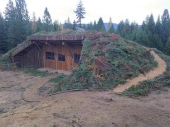Jocelyn Campbell wrote:Hi Ed, I'll let others more qualified than myself answer your questions. This latest image from Tim Skufca might help clarify some things.
Ed, I agree, Oehler's design of the tongue and groove shoring seems inadequate, (for the roof decking as well). Tim Wheaton (Big Tim) and I discussed the roof decking, which will be a series of 6 to 8" diameter logs filled in with 2 to 4" diam. logs. The tips and butts will be alternated, with the small logs filling in where needed. I imagine a similar system for the wall shoring with each course pinned where possible. If a smoother wall surface is desired, I know the mill is churning out some material that could work, but, as you point out, the 10 foot span is too great of a span for 2x material. I would suggest maybe two intermediate posts to break up the span.
Paul, as far as your critique on the wing-wall design, the Sketch-up drawing doesn't show too well that there is a 5 foot overhang over the gable. This should adequately protect the front two log posts and the shoring wall. The series of vertical log posts at the end of the wing wall would basically be sacrificial logs. This is the same design that is detailed in Sepp Holzer's
Permiculture book, pages 96 - 100. These posts will last several years, and are there mostly to protect the rest of that wall by supporting the overhang. The angle of these wing-walls from the main structure should relate to the site, and the amount of fill required.
Of course, this issue would not exist if the use of concrete was allowed. This brings up a question: could the use of the diesel-powered track-hoe be swapped for some key areas where it's hard to beat concrete? [remember, the Romans used grout that still is holding structures today] Just thought I'd add a little fodder to the forum.











